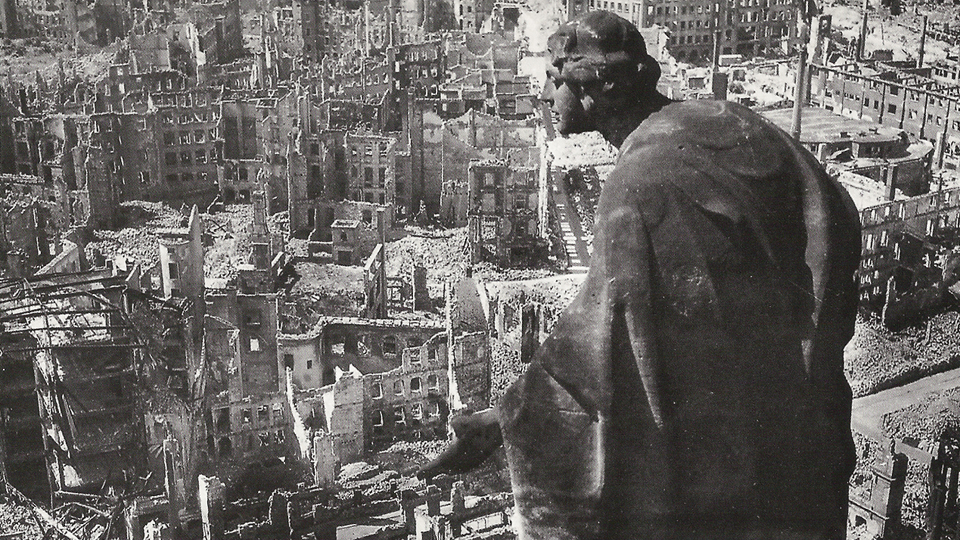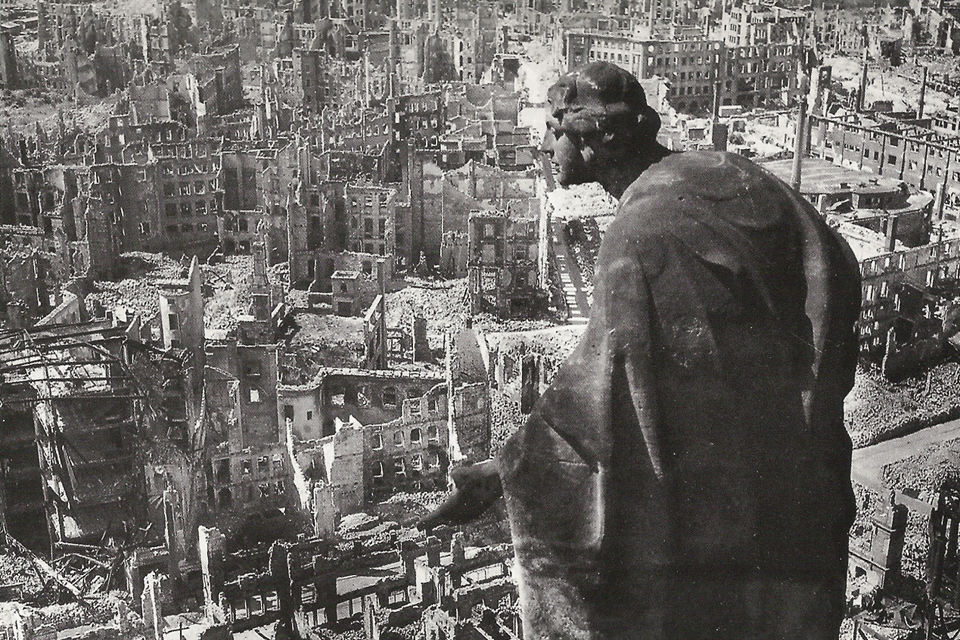Im Zuge der am 14. Februar 1942 erlassenen „Area Bombing Directive“, der direkten Anweisung des britischen Luftfahrtministeriums zum Flächenbombardement, flogen zwischen dem 13. und 15. Februar 1945 britische und amerikanische Luftstreitkräfte vier Angriffswellen gegen die sächsische Kunst- und Kulturstadt Dresden.
Bereits während der ersten beiden Angriffswellen, 22:03 Uhr sowie 1:23 Uhr, in der Nacht vom 13. zum 14. Februar 1945, warfen 773 britische Bomber eine Bombenlast von 2400 Tonnen über Dresden ab. Binnen weniger Minuten wurde die Altstadt in Brand gesetzt. Beide Bombardements umfassten ein Gebiet von 15 Quadratkilometern. Bei den darauf folgenden Tagesangriffen amerikanischer Luftstreitkräfte am 14. und 15. Februar brachten insgesamt mehr als 500 Bomber, begleitet von bis zu 200 Jägern, mit dem Abwurf einer Bombenlast von 1234 Tonnen abermals Tod und Verderben über die geschundene Elbestadt.
Unter der Führung von Sir Arthur Travers Harris wurden von der Royal Air Force (RAF) zahlreiche deutsche Städte schwer zerstört, so etwa Hamburg (Juli/August 1943), Braunschweig (15. Oktober 1944), Magdeburg (16. Januar 1945), Dresden (13. – 15. Februar 1945), Pforzheim (23. Februar 1945), Mainz (27. Februar 1945), Würzburg (16. März 1945) und Hildesheim (22. März 1945). Der seit Februar 1942 Oberkommandierende des Bomber Command der RAF war ein glühender Verfechter des so genannten „Moral Bombing“, also dem Flächenbombardement um die Moral und den Widerstandswillen der deutschen Bevölkerung zu brechen. Dass dies auch ganz bewusst die Vernichtung ziviler Ziele einbezog verdeutlicht ein Zitat des RAF-Stabschefs, ab 1944 Marschall der Royal Air Force und ebenfalls Verfechter der Flächenangriffsstrategie, Sir Charles Portal.
„Ich nehme an, dass klar ist, dass die Ziele bebaute Gebiete und nicht z. B. Schiffswerften oder Flugzeugwerke lt. Anhang A sein werden. Dies muss jedem klargemacht werden, falls es noch nicht so verstanden worden ist.“
NEVER FORGET DRESDEN!
In the course of the „Area Bombing Directive“ issued on February 14th, 1942, the direct order of the British Air Ministry for surface bombardment, between 13th and 15th February 1945, british and american air forces flew four attack waves against the saxon city of Dresden.
Already during the first two attack waves, 22:03 o’clock and 1:23 o’clock, in the night of 13th to 14th February 1945, 773 british bombers threw a bomb load of 2400 tons over Dresden. Within a few minutes, the old town was set on fire. Both bombings covered an area of 15 square kilometers. In the following daily attacks, on 14th and 15th February, american air forces with a total of more than 500 bombers, accompanied by up to 200 fighters, brought with the dropping of a bomb load of 1234 tons, again death and destruction over the battered city at the river Elbe.
Under the leadership of Sir Arthur Travers Harris, numerous german cities were seriously damaged by the Royal Air Force (RAF), such as Hamburg (July / August 1943), Braunschweig (October 15th, 1944), Magdeburg (January 16th, 1945), Dresden (February 13th-15th, 1945), Pforzheim (February 23rd, 1945), Mainz (February 27th, 1945), Würzburg (March 16th, 1945), and Hildesheim (March 22nd, 1945). The commander-in-chief of the RAF’s Bomber Command since February 1942 was a fervent supporter of the so-called „Moral Bombing“, that is, the area-bombardment to break the morale and resistance of the german population. The fact that this deliberately included the destruction of civilian targets is illustrated by a quotation from the RAF Chief of Staff, Marshal of the Royal Air Force from 1944 and also an advocate of the surface attack strategy, Sir Charles Portal.
„I assume that it is clear that the targets are built-up areas and will not be shipyards or aircraft plants for example, according to annex A. This must be made clear to everyone, if it has not been understood that way.“


